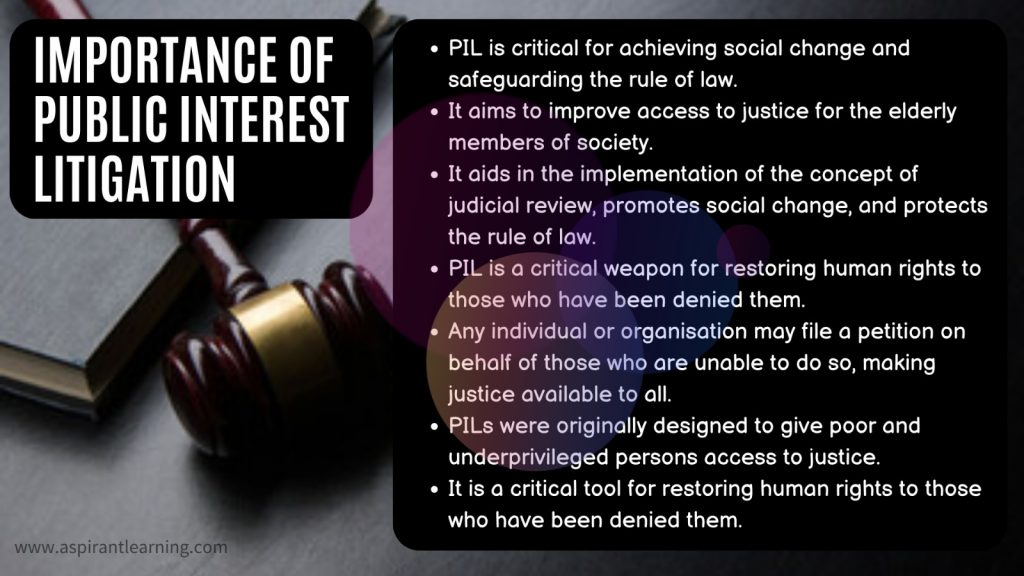News Highlight
Motivated Public Interest Litigation (PIL) poses a grave danger to the credibility of the judicial process.
Key Takeaway
- The Delhi High Court warned against frivolous PILs, saying that courts must carefully evaluate whether people who approach them with PILs are genuine or acting for personal or political advantage.
- PILs that are motivated endanger the credibility of the court process.
- Furthermore, they have a history of jeopardising the integrity of other institutions and undermining public trust in democracy and the rule of law.
Public Interest Litigation (PIL)
- About
- The use of the law to promote human rights and equality.
- As well as to raise issues of general public concern, it is known as public interest litigation (PIL).
- It helps underprivileged and marginalised minorities speak up in defence of their fundamental human rights.
- The primary purpose of PILs is to protect the fundamental rights of those who cannot represent themselves in court.
- In most circumstances, the person or entity who has been injured seeks justice in the courts.
- But, in PIL, anybody can file a complaint or an appeal on behalf of the victims.
- A PIL enables a socially conscious citizen or a public-spirited non-governmental organisation to pursue a public cause by seeking judicial redress of a public injury.
- It is not defined by legislation or statute.
- It was founded in India by the court in the 1970s and 1980s when it opted to address concerns about human rights breaches.
Significance of PIL
- PIL aims to provide ordinary people access to the courts to get legal redress.
- PIL is a crucial tool for social transformation, preserving the rule of law and speeding the balance of law and justice.
- The initial goal of PILs was to make justice available to the poor and marginalised.
- It is a crucial tool for bringing human rights to those denied them.
- It equalises access to justice for all.
- It aids in the judicial oversight of governmental institutions such as prisons, asylums, and protective homes.
- It is an important tool for putting judicial review into action.
- Introducing PILs ensures increased public engagement in the judicial review of administrative action.
Ambit of the PILs in India
- Violation of the basic human rights of the poor.
- Content and conduct of the government and its policymaking.
- Labour exploitation issues.
- Women rights.
- Caste and religious issues.
- Governance issues and the working of public bodies: Local, state, and the union.
- Environmental issues.
- The issues of culture and heritage.
- Other matters of public importance.
Criticism against PIL in India
- The courts have done little to prevent the filing of bogus PILs.
- This adds to the already overburdened court system.
- The number of fake PILs that are still pending in court has an impact on the status of socioeconomically meaningful PILs.
- A key issue is that PIL cases merely provide symbolic justice.
- There are two ways to interpret symbology.
- Firstly, as the Vishakha recommendations indicated, passing legislation takes too long, rendering court orders ineffective.
- Secondly, DPSPs are converted to FRs when the state cannot enforce them.
- Fundamental rights are compromised when established rights cannot be enforced.
- While purporting to serve the public interest, PILs have been abused for personal gain.
- PILs filed in secret in the name of the public interest have forced the suspension of several commendable efforts.
- This has been used to establish a framework for competing rights.
- When a court orders the closure of a polluting enterprise, for example, the interests of the workers and their families who lose their source of income may be overlooked.
- The practice of public interest litigation (PIL) usually results in judicial overreach.
- As a result, the judiciary becomes a game changer.

Conclusion
- Public Interest Litigation has yielded astounding achievements that would have been impossible three decades ago.
- With judicial intervention, degraded bonded labourers, tortured under trials and women prisoners, humiliated inmates of protected women’s homes, blinded convicts, exploited children, beggars, and many more have received redress.
- The most significant achievement of PIL has been to increase government accountability for poor people’s human rights.
- The PIL establishes a new jurisprudence of the state’s accountability for constitutional and legal infractions that harm the interests of the community’s weakest members.
- Nonetheless, the Judiciary should use PILs cautiously to avoid Judicial Overreach violating the Separation of Power principle.
- Furthermore, frivolous PILs with vested interests must be avoided to manageable the burden.
Pic Courtesy: iPleaders
Content Source: The Hindu



